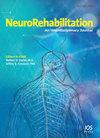Effect of normal-walking-pattern-based functional electrical stimulation on gait of the lower extremity in subjects with ischemic stroke: A self controlled study.
IF 1.8
4区 医学
Q3 CLINICAL NEUROLOGY
引用次数: 13
Abstract
BACKGROUND Functional electrical stimulation is a widely used technique for rehabilitation. OBJECTIVE To assess the efficacy of walking-pattern-based four-channel functional electric stimulation and its influence on the gait features of stroke patients with hemiplegia. METHODS A total of 21 stroke patients with hemiplegia were enrolled into the study. The walking gaits of patients were investigated before, during and after walking-pattern-based FES treatment using the gait analysis system. The changes of gait indexes were comparatively analyzed. RESULTS After walking-pattern-based FES therapy, the pace, stride rate, gait cycle, and step length of stroke patients with hemiplegia were 50.19 ± 14.45 cm/s, 36.85 ± 5.85 time/min, 1.6643 ± 0.2626 sec, 80.3333 ± 15.1438 cm, respectively. The motion range of hip and knee joint were 47.5238 ± 10.7453, 56.7619 ± 14.5255, respectively. We found these indexes were significantly improved compared with those before FES treatment (P < 0.05). The single swing rate (injured extremity/uninjured extremity) after FES treatment was 1.5589 ± 0.4550. The statistical results showed that the gait cycle, pace, stride rat, and single swing rate (injured extremity/uninjured extremity) were significantly improved after FES treatment (P < 0.05). CONCLUSIONS Our results demonstrate that walking-paradigm based FES we developed is effective for treating stroke patients during rehabilitation.基于正常行走模式的功能性电刺激对缺血性脑卒中患者下肢步态的影响:一项自我对照研究。
功能电刺激是一种广泛应用于康复治疗的技术。目的评价基于步行模式的四通道功能电刺激对脑卒中偏瘫患者步态特征的影响。方法选取脑卒中偏瘫患者21例。采用步态分析系统对基于步行模式的FES治疗前后患者的步行步态进行研究。对比分析步态指标的变化。结果基于步行模式的FES治疗后,脑卒中偏瘫患者的步速、步幅、周期、步长分别为50.19±14.45 cm/s、36.85±5.85 time/min、1.6643±0.2626 sec、80.3333±15.1438 cm。髋关节、膝关节活动范围分别为47.5238±10.7453、56.7619±14.5255。与FES治疗前比较,这些指标均有显著改善(P < 0.05)。FES治疗后单肢摆动率(损伤肢/未损伤肢)为1.5589±0.4550。统计结果显示,FES治疗后,大鼠的步态周期、步速、步幅、单次摆动率(损伤肢/未损伤肢)均有显著改善(P < 0.05)。结论基于步行模式的FES对脑卒中患者康复治疗有效。
本文章由计算机程序翻译,如有差异,请以英文原文为准。
求助全文
约1分钟内获得全文
求助全文
来源期刊

NeuroRehabilitation
CLINICAL NEUROLOGY-REHABILITATION
CiteScore
3.20
自引率
0.00%
发文量
178
审稿时长
6-12 weeks
期刊介绍:
NeuroRehabilitation, an international, interdisciplinary, peer-reviewed journal, publishes manuscripts focused on scientifically based, practical information relevant to all aspects of neurologic rehabilitation. We publish unsolicited papers detailing original work/research that covers the full life span and range of neurological disabilities including stroke, spinal cord injury, traumatic brain injury, neuromuscular disease and other neurological disorders.
We also publish thematically organized issues that focus on specific clinical disorders, types of therapy and age groups. Proposals for thematic issues and suggestions for issue editors are welcomed.
 求助内容:
求助内容: 应助结果提醒方式:
应助结果提醒方式:


